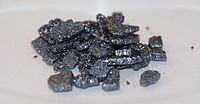
Photo from wikipedia
The soft nature of organic–inorganic halide perovskites renders their lattice particularly tunable to external stimuli such as pressure, undoubtedly offering an effective way to modify their structure for extraordinary optoelectronic… Click to show full abstract
The soft nature of organic–inorganic halide perovskites renders their lattice particularly tunable to external stimuli such as pressure, undoubtedly offering an effective way to modify their structure for extraordinary optoelectronic properties. Here, using the methylammonium lead iodide as a representative exploratory platform, it is observed that the pressure-driven lattice disorder can be significantly suppressed via hydrogen isotope effect, which is crucial for better optical and mechanical properties previously unattainable. By a comprehensive in situ neutron/synchrotron-based analysis and optical characterizations, a remarkable photoluminescence (PL) enhancement by threefold is convinced in deuterated CD3ND3PbI3, which also shows much greater structural robustness with retainable PL after high peak-pressure compression–decompression cycle. With the first-principles calculations, an atomic level understanding of the strong correlation among the organic sublattice and lead iodide octahedral framework and structural photonics is proposed, where the less dynamic CD3ND3 cations are vital to maintain the long-range crystalline order through steric and Coulombic interactions. These results also show that CD3ND3PbI3-based solar cell has comparable photovoltaic performance as CH3NH3PbI3-based device but exhibits considerably slower degradation behavior, thus representing a paradigm by suggesting isotopefunctionalized perovskite materials for better materials-by-design and more stable photovoltaic application.
Journal Title: Advanced Functional Materials
Year Published: 2020
Link to full text (if available)
Share on Social Media: Sign Up to like & get
recommendations!